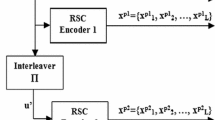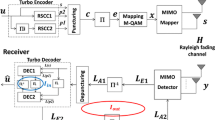Abstract
A joint source–channel decoding scheme (JSCD) with iterative bit combining (IBC) is proposed, which exploits two types of a priori information. The first one is the a priori bit probabilities obtained from source statistics, and the second is the channel a priori probabilities obtained from saved extrinsic information of previous transmissions. The JSCD-IBC scheme also incorporates iterative detection as both a stopping criteria and mechanism for triggering retransmissions. This adds an implicit adaptivity to the system and prevents excess iterations/retransmissions from being effected. The performance of the JSCD-IBC scheme is evaluated with four different iterative detection schemes and also two different types of variable length codes, Huffman and reversible variable length codes. Simulation results show that a significant performance gain in terms of bit error rate, throughput, and number of iterations can be achieved with the JSCD-IBC scheme as compared to a separate decoding scheme.















Similar content being viewed by others
References
Shannon CE (1948) A mathematical theory of communication. Bell Syst Tech J 27:379–423
Nosratinia A, Lu J, Aazhang B (2003) Source–channel rate allocation for progressive transmission of images. IEEE Trans Commun 51:186–196
Thomos N, Boulgouris NV, Strintzis MG (2005) Wireless image transmission using turbo codes and optimal unequal error protection. IEEE Trans Image Process 14(11):1890–1901
Fowdur TP, Soyjaudah KMS (2008) Robust JPEG image transmission using unequal error protection and code combining. Int J Commun Syst 21:1–24
Perkis A (2001) On the importance of error resilience in visual communications over noisy channels. Circuits Syst Signal Process 20(3):415–446
Takishima Y, Wada M, Murakami H (1995) Reversible variable length codes. IEEE Trans Commun 43:158–162
Murad AH, Fuja TE (1998) Joint source–channel decoding of variable length encoded sources. In: Proceedings of the Information Theory Workshop (ITW). Killarney, Ireland, pp 94–95, June
Jeanne M, Carlach JC, Siohan P (2005) Joint source–channel decoding of variable length codes for convolutional codes and turbo codes. IEEE Trans Commun 53(1):10–15
Bauer R, Hagenauer J (2000) Symbol-by-symbol MAP decoding of variable length codes. In: Proceedings of the 3rd ITG Conference on Source and Channel Coding, Munich, Germany, pp 111–116, Jan
Kliewer J, Thobaben R (2002) Combining FEC and optimal soft-input source decoding for the reliable transmission of correlated variable-length encoded signals. In: Proceedings of the IEEE Data Compression Conference. Snowbird, UT, USA, pp 83–91, Apr
Hagenauer J, Offer E, Papke L (1996) Iterative decoding of binary block and convolutional codes. IEEE Trans Inform 42:429–445
Shao RY, Lin S, Fossorier MPC (1999) Two simple stopping criteria for turbo decoding. IEEE Trans Commun 47(8):1117–1120
Wu Y, Woerner B, Ebel J (2000) A simple stopping criterion for turbo decoding. IEEE Commun Lett 4(8):258–260
Narayanan KR, Stüber GL (1997) A novel ARQ technique using the turbo coding principle. IEEE Commun Lett 1:49–51
Uhlemann E, Aulin TM, Rasmussen LK, Wiberg P-A (2003) Packet combining and doping in concatenated hybrid ARQ schemes using iterative decoding. In: Proceedings of the IEEE Wireless Communications and Networking Conference, New Orleans, LA, pp 849–854, March
Vucetic B, Yuan J (2000) Turbo codes: principles and applications. Kluwer, Dordrecht
Acknowledgments
The financial contribution of the Tertiary Education Commission of Mauritius and of the University of Mauritius is duly acknowledged.
Author information
Authors and Affiliations
Corresponding author
Rights and permissions
About this article
Cite this article
Fowdur, T.P., Soyjaudah, K.M.S. Performance of joint source–channel decoding with iterative bit combining and detection. Ann. Telecommun. 63, 409–423 (2008). https://doi.org/10.1007/s12243-008-0039-0
Received:
Accepted:
Published:
Issue Date:
DOI: https://doi.org/10.1007/s12243-008-0039-0




